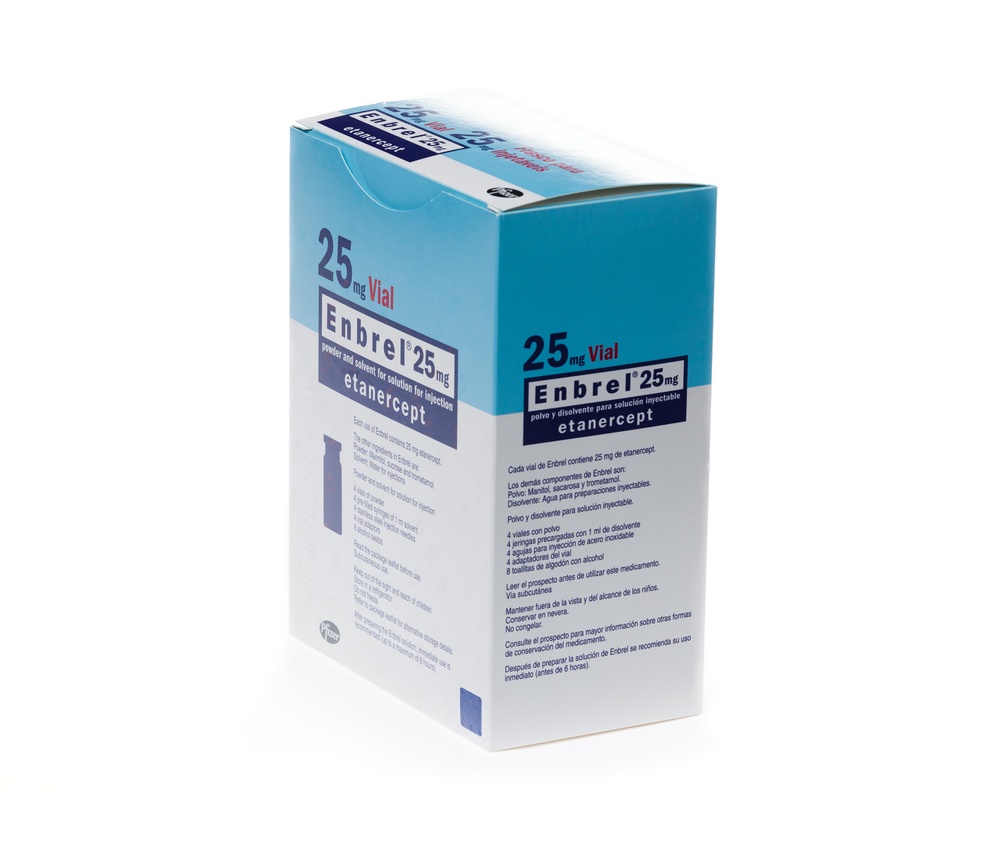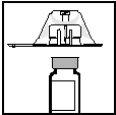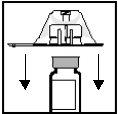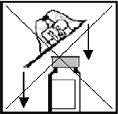
How to use ENBREL 25 mg POWDER AND SOLVENT FOR SOLUTION FOR INJECTION
Introduction
Package Leaflet: Information for the User
Enbrel 25 mg powder and solvent for solution for injection
etanercept
Read all of this leaflet carefully before you start using this medicine because it contains important information for you.
|
Contents of the pack
The information in this leaflet is organized into the following 7 sections:
- What is Enbrel and what is it used for
- What you need to know before you use Enbrel
- How to use Enbrel
- Possible side effects
- Storing Enbrel
- Contents of the pack and other information
- Instructions for use
1. What is Enbrel and what is it used for
Enbrel is a medicine that is made from two human proteins. It blocks the activity of another protein in the body that causes inflammation. Enbrel works by reducing inflammation associated with certain diseases.
Enbrel can be used in adults aged 18 years or older to treat moderate or severe rheumatoid arthritis, psoriatic arthritis, severe axial spondyloarthritis, including ankylosing spondylitis, and moderate or severe psoriasis, usually depending on each case, when other treatments have not been effective enough or are not suitable for you.
In the treatment of rheumatoid arthritis, Enbrel is usually used in combination with methotrexate, although it can also be used as the only medicine if treatment with methotrexate is not suitable for you. Enbrel can slow down the damage caused by rheumatoid arthritis to your joints and improve your ability to perform daily activities, whether used alone or in combination with methotrexate.
In patients with psoriatic arthritis with multiple joint involvement, Enbrel can improve their ability to perform normal daily activities. In patients with multiple symmetrical joints that are swollen or painful (e.g., hands, wrists, and feet), Enbrel can delay the progression of structural damage to these joints caused by the disease.
Enbrel is also indicated for the treatment of children and adolescents with the following diseases:
- For the following types of juvenile idiopathic arthritis when treatment with methotrexate has not worked adequately, or is not suitable for them:
- Polyarthritis (with positive or negative rheumatoid factor) and extended oligoarthritis in patients aged 2 years or older.
- Psoriatic arthritis in patients aged 12 years or older.
- For enthesitis-related arthritis in patients aged 12 years or older for whom the use of other commonly used treatments has not worked adequately, or such treatments are not suitable for them.
- Severe psoriasis in patients aged 6 years or older who have had an inadequate response to (or are unable to take) phototherapies or other systemic therapies.
2. What you need to know before you use Enbrel
Do not use Enbrel
- if you or the child in your care are allergic to etanercept or any of the other ingredients of Enbrel (listed in section 6). If you or the child experience allergic reactions, such as chest tightness, wheezing, dizziness, or rash, do not inject more Enbrel and contact your doctor immediately.
- if you or the child have or are at risk of developing a severe blood infection called sepsis. If you are not sure, consult your doctor.
- if you or the child have any type of infection. If you are not sure, consult your doctor.
Warnings and precautions
Consult your doctor before starting treatment with Enbrel.
- Allergic reactions: If you or the child experience allergic reactions such as chest tightness, wheezing, dizziness, or rash, do not inject more Enbrel and contact your doctor immediately.
- Latex: The syringe cap is made of latex (dry natural rubber). Contact your doctor before using Enbrel if the syringe is to be handled by, or if Enbrel is to be administered to, someone with known or possible latex allergy.
- Infections/surgery: If you or the child develop a new infection or are about to undergo major surgery, your doctor may want to monitor your treatment with Enbrel.
- Infections/diabetes: Inform your doctor if you or the child have a history of recurrent infections or have diabetes or other disorders that increase the risk of infection.
- Infections/monitoring: Inform your doctor of any recent travel outside the European region. If you or the child develop symptoms of an infection such as fever, chills, or cough, notify your doctor immediately. Your doctor should decide whether to continue monitoring you or the child for infections after you or the child stop treatment with Enbrel.
- Tuberculosis: Since cases of tuberculosis have been reported in patients treated with Enbrel, your doctor will examine you for signs and symptoms of tuberculosis before starting Enbrel. This may include a thorough review of your medical history, chest X-ray, and tuberculosis test. The performance of these tests should be recorded on the Patient Information Card. It is very important that you tell your doctor if you or the child have had tuberculosis or have been in close contact with someone who has had tuberculosis. If symptoms of tuberculosis (such as persistent cough, weight loss, listlessness, moderate fever) or any other infection appear during or after treatment, inform your doctor immediately.
- Hepatitis B: Inform your doctor if you or the child have or have had hepatitis B. Your doctor should perform a hepatitis B test before you or the child start treatment with Enbrel. Treatment with Enbrel may reactivate hepatitis B in patients who have previously been infected with the hepatitis B virus. If this happens, you or the child should stop using Enbrel.
- Hepatitis C: Inform your doctor if you or the child have hepatitis C. Your doctor may want to monitor your treatment with Enbrel in case the infection worsens.
- Blood disorders: Inform your doctor immediately if you or the child have signs or symptoms such as persistent fever, sore throat, bruising, bleeding, or paleness. Such symptoms may indicate a serious blood problem that requires discontinuation of treatment with Enbrel.
- Nervous system and vision disorders: Inform your doctor if you or the child have multiple sclerosis, optic neuritis (inflammation of the optic nerves), or transverse myelitis (inflammation of the spinal cord). Your doctor will decide whether Enbrel is a suitable treatment.
- Congestive heart failure: Inform your doctor if you or the child have a history of congestive heart failure, as Enbrel needs to be used with caution in these circumstances.
- Cancer: Inform your doctor if you have or have had lymphoma (a type of blood cancer) or any other cancer before you are given Enbrel.
Patients with severe rheumatoid arthritis who have had the disease for a long time may be at a higher than average risk of developing lymphoma.
Children and adults taking Enbrel may have an increased risk of developing lymphoma or other cancers.
Some adolescent and child patients who have received Enbrel or other medicines that work in a similar way to Enbrel have developed cancers, including unusual types, which sometimes resulted in death.
Some patients who receive Enbrel have developed skin cancers. Inform your doctor if you or the child develop any changes in the appearance of the skin or growths on the skin.
- Chickenpox: Inform your doctor if you or the child are exposed to chickenpox while using Enbrel. Your doctor will decide whether preventive treatment for chickenpox is appropriate.
- Alcoholism: Enbrel should not be used to treat alcohol-related hepatitis. Please inform your doctor if you or the child in your care have a history of alcoholism.
- Wegener's granulomatosis: Enbrel is not recommended for the treatment of Wegener's granulomatosis, a rare inflammatory disease. If you or the child in your care have Wegener's granulomatosis, discuss this with your doctor.
- Anti-diabetic medicines: Inform your doctor if you or the child have diabetes or are taking medicines to treat diabetes. Your doctor may decide whether you or the child need less anti-diabetic medicine while taking Enbrel.
Children and adolescents
Vaccinations: If possible, children should have all vaccinations up to date before using Enbrel. Some vaccines, such as oral polio vaccine, should not be given while using Enbrel. Consult your doctor before you or the child use any vaccine.
Enbrel should not normally be used in children under 2 years of age with polyarthritis or extended oligoarthritis, in children under 12 years of age with enthesitis-related arthritis or psoriatic arthritis, or in children under 6 years of age with psoriasis.
Other medicines and Enbrel
Inform your doctor or pharmacist if you or the child are using, have recently used, or might use any other medicines (including anakinra, abatacept, or sulfasalazine), even those not prescribed by your doctor. You or the child should not use Enbrel with medicines that contain the active substances anakinra or abatacept.
Pregnancy and breastfeeding
Enbrel should only be used during pregnancy if clearly necessary. Consult your doctor if you are pregnant, think you may be pregnant, or plan to become pregnant.
If you have received Enbrel during pregnancy, your baby may be at a higher risk of infection. Additionally, in one study, more birth defects were observed when the mother had received Enbrel during pregnancy, compared to mothers who had not received Enbrel or other similar medicines (TNF antagonists), but there was no pattern in the types of birth defects reported. Another study did not find an increased risk of congenital malformations when the mother had received Enbrel during pregnancy. Your doctor will help you decide whether the benefits of treatment outweigh the potential risk to your baby.
Consult your doctor if you wish to breastfeed while being treated with Enbrel. It is important that you inform the pediatrician and other healthcare professionals about the use of Enbrel during pregnancy and breastfeeding before your baby receives any vaccine.
Driving and using machines
It is not expected that the use of Enbrel will affect the ability to drive and use machines.
3. How to use Enbrel
Follow the instructions for administration of this medicine exactly as told by your doctor. If you are not sure, consult your doctor or pharmacist again.
If you think that the action of Enbrel is too strong or too weak, talk to your doctor or pharmacist.
Dose for adult patients (aged 18 years or older)
Rheumatoid arthritis, psoriatic arthritis, and axial spondyloarthritis, including ankylosing spondylitis
The usual dose is 25 mg administered twice a week or 50 mg administered once a week, by injection under the skin. However, your doctor may decide on an alternative frequency for injecting Enbrel.
Plaque psoriasis
The usual dose is 25 mg twice a week or 50 mg once a week.
Alternatively, 50 mg may be administered twice a week for up to 12 weeks, followed by 25 mg twice a week or 50 mg once a week.
Your doctor will decide how long you should take Enbrel and whether you need to repeat the treatment based on your response. If Enbrel does not have an effect on your disease after 12 weeks, your doctor may advise you to stop using this medicine.
Use in children and adolescents
The suitable dose and frequency of administration will depend on the child's or adolescent's weight and disease. The doctor will instruct you on how to prepare and measure the suitable dose.
For polyarthritis or extended oligoarthritis in patients aged 2 years or older, or enthesitis-related arthritis or psoriatic arthritis in patients aged 12 years or older, the usual dose is 0.4 mg of Enbrel per kg of body weight (up to a maximum of 25 mg) twice a week, or 0.8 mg of Enbrel per kg of body weight (up to a maximum of 50 mg) once a week.
For psoriasis in patients aged 6 years or older, the usual dose is 0.8 mg of Enbrel per kg of body weight (up to a maximum of 50 mg) once a week. If Enbrel does not have an effect on the child's disease after 12 weeks, your doctor may advise you to stop using this medicine.
Form and route of administration
Enbrel is administered by injection under the skin (subcutaneous injection).
Enbrel can be administered with or without food or drink.
The powder should be dissolved before use. In section 7, "Instructions for use", detailed instructions for the preparation and injection of Enbrel are included.The Enbrel solution should not be mixed with any other medicine.
To help you remember, it may be useful to note down in a diary which day(s) of the week you should use Enbrel.
If you use more Enbrel than you should
If you use more Enbrel than you should (either by injecting too much at one time or by using it too frequently), you should talk to a doctor or pharmacist immediately. Always carry the medicine pack with you, even if it is empty.
If you forget to inject Enbrel
If you miss a dose, you should inject it as soon as you remember, unless the next dose is scheduled for the next day, in which case you should omit the missed dose. Then continue injecting the medicine on the usual day(s). If you do not remember until the day you are due to have the next injection, do not inject a double dose (two doses on the same day) to make up for the missed dose.
If you stop treatment with Enbrel
Your symptoms may return after stopping treatment.
If you have any further questions on the use of this medicine, ask your doctor or pharmacist.
4. Possible Adverse Effects
Like all medicines, this medicine can cause adverse effects, although not all people suffer from them.
Allergic Reactions
If you observe any of the following reactions, do not inject more Enbrel. Inform your doctor immediately or go to the Emergency Service of the nearest hospital.
- Difficulty swallowing or breathing.
- Swelling of the face, throat, hands, and feet.
- Feeling of nervousness or anxiety, palpitations, sudden reddening of the skin, and/or feeling of heat.
- Severe rash, itching, or hives (prominent skin rashes, reddened or pale, often accompanied by itching).
Severe allergic reactions are rare. However, any of the above symptoms may be a sign of an allergic reaction to Enbrel, so you should seek immediate emergency medical attention.
Severe Adverse Effects
If you notice any of the following effects, you or the child may need urgent medical attention.
- Signs of severe infections, such as high fever that may be accompanied by cough, shortness of breath, chills, weakness, or a painful, sensitive, reddened, and warm area of skin or joints.
- Signs of blood disorders, such as bleeding, bruising, or paleness.
- Signs of nervous system disorders, such as numbness or tingling, vision changes, eye pain, or weakness in an arm or leg.
- Signs of heart failure or worsening of heart failure, such as fatigue or shortness of breath with activity, swelling of the ankles, feeling of fullness in the neck or abdomen, shortness of breath at night, or cough, blue discoloration of the nails or around the lips.
- Signs of cancer: cancer can affect any part of the body, including the skin and blood, and possible signs will depend on the type and location of the cancer. These signs may include weight loss, fever, swelling (with or without pain), persistent cough, presence of lumps or thickening of the skin.
- Signs of autoimmune reactions(in which antibodies that can damage normal body tissues develop) such as pain, itching, weakness, and abnormal breathing, thinking, feeling, or vision.
- Signs of lupus or lupus-like syndromesuch as weight changes, persistent rash, fever, muscle or joint pain, or fatigue.
- Signs of inflammation of blood vesselssuch as pain, fever, reddening or warmth of the skin, or itching.
These adverse effects are rare or infrequent, but they are serious conditions (some of which can be life-threatening). If these signs occur, inform your doctor immediately or go to the Emergency Service of the nearest hospital.
The following are the known adverse effects of Enbrel, grouped in decreasing order of frequency:
- Very common(may affect more than 1 in 10 people):
Infections (including colds, sinusitis, bronchitis, urinary tract infections, and skin infections); injection site reactions (including bleeding, bruising, reddening, itching, pain, and swelling) (do not occur as frequently after the first month of treatment; some patients have developed an injection site reaction that they had recently used); and headache.
- Common(may affect up to 1 in 10 people):
Allergic reactions; fever; rash; itching; antibodies directed against normal tissues (formation of autoantibodies).
- Uncommon(may affect up to 1 in 100 people):
Severe infections (including pneumonia, non-superficial skin infections, joint infections, blood infections, and generalized infections); worsening of congestive heart failure; low red blood cell count, low white blood cell count, low neutrophil count (a type of white blood cell); low platelet count; skin cancer (excluding melanoma); localized skin swelling (angioedema); hives (prominent skin rashes, reddened or pale, often accompanied by itching); eye inflammation; psoriasis (new or worsening); inflammation of blood vessels affecting multiple organs; increased liver enzymes in blood tests (in patients who also receive treatment with methotrexate, the increase in liver enzymes is frequent); abdominal cramps and pain, diarrhea, weight loss, or blood in the stool (signs of intestinal problems).
- Rare(may affect up to 1 in 1,000 people):
Severe allergic reactions (including severe localized skin swelling and wheezing); lymphoma (a type of blood cancer); leukemia (cancer that affects the blood and bone marrow); melanoma (a type of skin cancer); combined low count of red blood cells, white blood cells, and platelets; nervous system disorders (with severe muscle weakness and symptoms similar to those of multiple sclerosis or inflammation of the optic nerves or spinal cord); tuberculosis; new-onset congestive heart failure; seizures; lupus or lupus-like syndrome (symptoms may include persistent rash, fever, joint pain, and fatigue); skin rash that can lead to severe blistering and peeling of the skin; lichenoid reactions (itchy reddish-purple skin rash and/or thick white-gray lines on the mucous membranes); autoimmune hepatitis (in patients who also receive treatment with methotrexate, the frequency is uncommon); immunological disorder that can affect the lungs, skin, and lymph nodes (sarcoidosis); inflammation or scarring of the lungs (in patients who also receive treatment with methotrexate, the frequency of inflammation or scarring of the lungs is uncommon); damage to the small filters within the kidneys that lead to impaired kidney function (glomerulonephritis).
- Very rare(may affect up to 1 in 10,000 people):
Failure of the bone marrow to produce crucial blood cells.
- Frequency not known(cannot be estimated from the available data):
Merkel cell carcinoma (a type of skin cancer); Kaposi's sarcoma, a rare cancer related to human herpesvirus 8 infection. Kaposi's sarcoma usually manifests more frequently as purple skin lesions; excessive activation of white blood cells associated with inflammation (macrophage activation syndrome); reactivation of hepatitis B (a liver infection); worsening of a disease called dermatomyositis (inflammation and weakness of the muscles accompanied by skin rash).
Other Adverse Effects in Children and Adolescents
The adverse effects observed in children and adolescents, as well as their frequencies, are similar to those previously described.
Reporting of Adverse Effects
If you experience any type of adverse effect, consult your doctor or pharmacist, even if it is a possible adverse effect that is not listed in this leaflet. You can also report them directly through the Spanish Pharmacovigilance System for Human Use Medicines: www.notificaRAM.es. By reporting adverse effects, you can contribute to providing more information on the safety of this medicine.
5. Storage of Enbrel
Keep this medicine out of the sight and reach of children.
Do not use this medicine after the expiration date that appears on the packaging and label after "EXP". The expiration date is the last day of the month indicated.
Store in a refrigerator (2 °C - 8 °C). Do not freeze.
Before preparing the Enbrel solution, Enbrel can be stored outside the refrigerator at a maximum temperature of 25 °C, and for a single period of up to 4 weeks; after which, the medicine cannot be refrigerated again. Enbrel must be discarded if it has not been used within 4 weeks of being removed from the refrigerator. It is recommended that you note the date on which Enbrel was removed from the refrigerator and the date from which Enbrel must be discarded (not later than 4 weeks from the removal of the package from the refrigerator).
After preparing the Enbrel solution, it is recommended to use it immediately. However, the solution can be used during the 6 hours following reconstitution when stored at temperatures not exceeding 25 °C.
Do not use this medicine if you observe that the solution is not transparent or contains particles. The solution must be transparent, colorless to pale yellow or pale brown, without lumps, scales, or particles.
Properly discard any Enbrel solution that has not been injected before 6 hours.
Medicines should not be thrown away in drains or trash. Ask your pharmacist how to dispose of packages and medicines that are no longer needed. This will help protect the environment.
6. Container Contents and Additional Information
Composition of Enbrel
The active ingredient of Enbrel is etanercept. Each vial of Enbrel 25 mg contains 25 mg of etanercept.
The other components are:
Powder: Mannitol (E421), sucrose, and trometamol
Solvent: Water for injectable preparations
Appearance of the Product and Container Contents
Enbrel 25 mg is presented as a white powder and solvent for injectable solution (powder for injectable). Each container contains 4, 8, or 24 single-dose vials, 4, 8, or 24 prefilled syringes with water for injectable preparations, 4, 8, or 24 needles, 4, 8, or 24 vial adapters, and 8, 16, or 48 cotton balls with alcohol. Only some package sizes may be marketed.
Marketing Authorization Holder: Pfizer Europe MA EEIG Boulevard de la Plaine 17 1050 Brussels Belgium | |
Manufacturer: Pfizer Manufacturing Belgium NV Rijksweg 12, 2870 Puurs-Sint-Amands Belgium |
You can request more information about this medication by contacting the local representative of the marketing authorization holder:
Spain
Pfizer, S.L.
Phone: +34 91 490 99 00
Date of the Last Revision of this Prospectus:
Detailed information about this medication is available on the European Medicines Agency website: http://www.ema.europa.eu.
- Instructions for Use
This section is divided into the following subsections:
- Introduction
- Prepare for an Injection
- Prepare the Enbrel Dose for Injection
- Add the Solvent
- Extract the Enbrel Solution from the Vial
- Place the Needle on the Syringe
- Choose an Injection Site
- Prepare the Injection Site and Inject the Enbrel Solution
- Dispose of Materials
- Introduction
The following instructions explain how to prepare and inject Enbrel. Read the instructions carefully and follow them step by step. Your doctor or nurse will teach you the self-injection or administration techniques to a child. Do not attempt to administer an injection until you are sure you understand how to prepare the injection and administer the injection.
This injection should not be mixed with any other medication.
- Prepare for an Injection
- Wash your hands thoroughly.
- Choose a good light and a flat work surface.
- The tray should contain the items listed below. (If it does not, do not use it and consult your pharmacist). Use only the listed items. DO NOTuse any other syringe.
1 Enbrel Vial
1 Prefilled Syringe containing clear, colorless solvent (water for injectable preparations)
1 Needle
1 Vial Adapter
2 Cotton Balls with Alcohol
- Check the expiration date on the vial and syringe labels. They should not be used after the month and year indicated on them.
- Prepare the Enbrel Dose for Injection
- Remove the contents of the tray.
- Remove the plastic cap from the Enbrel vial (see Figure 1). DO NOTremove the gray stopper or the aluminum cap that surrounds the top of the vial.
Figure 1
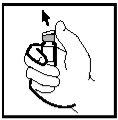
- Use a new alcohol swab to clean the vial stopper of Enbrel. After cleaning, do not touch the stopper with your hands or let it touch any surface.
- Place the vial upright on a clean, flat surface.
- Remove the paper covering the vial adapter package.
- While still in the plastic package, place the vial adapter over the top of the Enbrel vial, so that the adapter's spike is centered within the circle on the top of the vial stopper (Figure 2).
- Hold the vial firmly with one hand on the flat surface. With the other hand, push the adapter package STRAIGHT DOWNuntil you feel the adapter spike penetrate the vial stopper and UNTIL YOU FEEL AND HEAR THE ADAPTER EDGE CLICK INTO PLACE(see Figure 3). DO NOTpush the adapter at an angle (see Figure 4). It is essential that the adapter spike penetrates the vial stopper completely.
Figure 2 | Figure 3 | Figure 4 |
|
|
|
CORRECT | INCORRECT |
- While holding the vial in one hand, remove the plastic package from the vial adapter (see Figure 5).
Figure 5
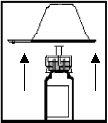
- Remove the protective cover from the syringe tip by breaking the white cap along the perforation. This is done by holding the white cap ring with one hand and the syringe tip with the other hand, bending it up and down until it breaks (see Figure 6). DO NOTremove the white ring that remains attached to the syringe.
Figure 6
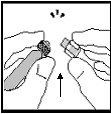
- Do not use the syringe if the perforation is already broken. Start again with another dose tray.
- Holding the glass body of the syringe (not the white ring) in one hand and the vial adapter (not the vial) in the other hand, connect the syringe to the vial adapter by inserting the tip into the opening and turning it clockwise until it is completely secure (see Figure 7).
Figure 7
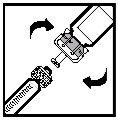
- Add the Solvent
- While holding the vial upright on a flat surface, push the plunger VERY SLOWLYuntil all the solvent enters the vial. This will help reduce foam formation (many bubbles) (see Figure 8).
- Once the solvent has been added to Enbrel, the plunger may move on its own. This is due to air pressure and is not a cause for concern.
Figure 8
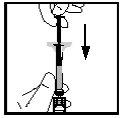
- With the syringe still inserted, slowly move the vial in circles for a few minutes to dissolve the powder (see Figure 9). DO NOTshake the vial. Wait until all the powder has dissolved (usually less than 10 minutes). The solution should be clear and colorless to pale yellow or pale brown, without lumps, scales, or particles. It is normal for white foam residue to remain in the vial. DO NOTuse Enbrel if all the powder in the vial has not dissolved within 10 minutes. Start again with another dose tray.
Figure 9
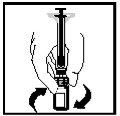
- Extract the Enbrel Solution from the Vial
- With the syringe still inserted in the vial and its adapter, hold the inverted vial at eye level. Push the plunger completely into the syringe (see Figure 10).
Figure 10
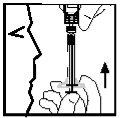
- Then, slowly pull the plunger back to extract the liquid into the syringe (see Figure 11). For adult patients, extract the total volume. For children, extract only the portion of liquid that the child's doctor has indicated. After extracting Enbrel from the vial, you may find some air in the syringe. Do not worry, as the air will be eliminated in a later stage.
Figure 11
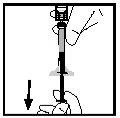
- Hold the inverted vial and separate the syringe from the vial adapter by turning it counterclockwise (see Figure 12).
Figure 12
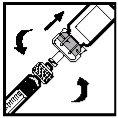
- Place the filled syringe on a clean, flat surface. Make sure the tip does not touch anything. Be careful not to push the plunger down.
(Note: After completing these steps, a small amount of liquid may remain in the vial. This is normal.)
- Place the Needle on the Syringe
- The needle is included in a plastic package to keep it sterile.
- To open the plastic package, hold the shorter, wider part in one hand. Place the other hand over the longer part of the package.
- To break the seal, bend the larger end up and down until it breaks (see Figure 13).
Figure 13
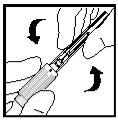
- Once the seal is broken, remove the shorter, wider part of the plastic package.
- The needle will remain in the longer part of the package.
- While holding the needle and package in one hand, take the syringe and insert its tip into the needle opening.
- Insert the syringe into the needle by turning it clockwise until it is completely secure (see Figure 14).
Figure 14
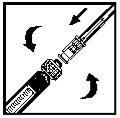
- Remove the needle cap from the syringe by pulling it firmly, being careful not to touch the needle and avoiding the needle touching any surface (see Figure 15). Be careful not to bend or twist the cap while removing it to avoid damaging the needle.
Figure 15
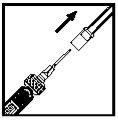
- While holding the syringe upright, eliminate the bubbles by slowly pushing the plunger until the air is removed (see Figure 16).
Figure 16
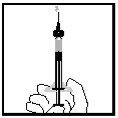
- Choose the Injection Site
- The three recommended injection sites for Enbrel include: (1) the middle front of the thighs; (2) the abdomen, except for the area 5 cm around the navel; and (3) the upper outer part of the arms (see Figure 17). If you are self-injecting, you should not inject into the upper outer part of the arms.
Figure 17
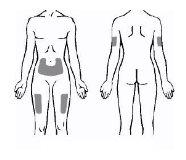
- A different site should be used for each new injection. Each new injection should be placed at least 3 cm from the previous injection site. DO NOTinject into sensitive, bruised, red, or hardened skin areas. Avoid areas with scars or stretch marks (It may be helpful to note the previous injection sites).
- If you or the child have psoriasis, you should try not to inject directly into any area of thickened, red, or scaly skin ("psoriatic skin lesions").
- Prepare the Injection Site and Inject the Enbrel Solution
- Clean the injection site where you will inject Enbrel with an alcohol swab, using a circular motion. DO NOTtouch this area again until the injection has been administered.
- When the previously cleaned skin area has dried, pinch it and hold it firmly with one hand. With the other hand, hold the syringe like a pencil.
- With a quick and short motion, push the needle all the way in, penetrating the skin at an angle between 45° and 90° (see Figure 18). With practice, you will find the angle that is most comfortable for you or the child. Be careful not to push the needle into the skin too slowly or with too much force.
Figure 18
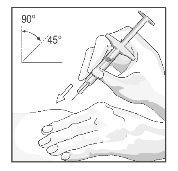
- When the needle is completely inserted into the skin, release the skin that you are holding. With your free hand, hold the needle near its base to stabilize it. Then, push the plunger to inject the entire solution at a SLOWand steady speed (see Figure 19).
Figure 19
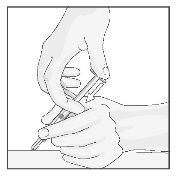
- When the syringe is empty, remove the needle from the skin; be careful to keep the syringe at the same angle it was when inserted.
- Press a cotton ball against the injection site for 10 seconds. There may be slight bleeding. DO NOTrub the injection site. If desired, you can apply a band-aid or bandage.
- Dispose of Materials
- The syringe and needles SHOULD NEVERbe reused. Dispose of them according to the instructions of your doctor, nurse, or pharmacist.
If you have any questions, consult a doctor, nurse, or pharmacist who is familiar with the use of Enbrel.
- Country of registration
- Active substance
- Prescription requiredYes
- Manufacturer
- This information is for reference only and does not constitute medical advice. Always consult a licensed doctor before taking any medication. Oladoctor is not responsible for medical decisions based on this content.
- Alternatives to ENBREL 25 mg POWDER AND SOLVENT FOR SOLUTION FOR INJECTIONDosage form: INJECTABLE, 25 mgActive substance: etanerceptManufacturer: Samsung Bioepis Nl B.V.Prescription requiredDosage form: INJECTABLE, 50 mgActive substance: etanerceptManufacturer: Samsung Bioepis Nl B.V.Prescription requiredDosage form: INJECTABLE, 50mgActive substance: etanerceptManufacturer: Samsung Bioepis Nl B.V.Prescription required
Alternatives to ENBREL 25 mg POWDER AND SOLVENT FOR SOLUTION FOR INJECTION in other countries
The best alternatives with the same active ingredient and therapeutic effect.
Alternative to ENBREL 25 mg POWDER AND SOLVENT FOR SOLUTION FOR INJECTION in Ukraine
Online doctors for ENBREL 25 mg POWDER AND SOLVENT FOR SOLUTION FOR INJECTION
Discuss dosage, side effects, interactions, contraindications, and prescription renewal for ENBREL 25 mg POWDER AND SOLVENT FOR SOLUTION FOR INJECTION – subject to medical assessment and local rules.



